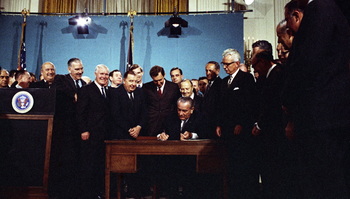The act asserts the authority of the Administrator of the EPA to provide plans for emission reductions for hazardous pollutants. It was amended in 1967,1970,1977, and, crucially, in 1990. This 1990 amendment, and the clerical errors that were made in its passing, are the source of one of the four major objections raised by 9 states attorneys general, out of a group of 26 who asked the D.C. Circuit Court of Appeals for a stay of the rule. Part of the CAA (Sec. 112), provides a list of "hazardous pollutants" that may be regulated under the clean air act. An earlier section (Sec. 111(d)), in an effort to eliminate the possibility of duplicate regulation, creates the so-called "112 exclusion" which, paraphrasing the 1970 wording, reads as follows: The Administrator shall prescribe regulations ... for any air pollutant ... which is not included on a list published under [Section 112] of this title In 1990, the House and Senate both drafted their own versions of the 1990 amendment. Both differed slightly in their wording of the Section 112 exemption, with the Senate version hewing to the original structure. The House version, however, introduced new language, reading The Administrator shall prescribe regulations ... for any existing source for any air pollutant ... which is not included on a list published under [Section 112] of this title Now there is a problem. A reasonable reading of this alternate text is as follows: the EPA may regulate emissions sources (power plans and automobiles), only if they are not currently regulated under Section 112, which places restrictions on a whole host of pollutants. CO2, however is not one of them. Since the CPP relies on the EPA's ability to regulate CO2, which is not included in Section 112, this essentially handcuffs the EPA: it may not introduce a rule that limits CO2 emissions from power plants, because they are already a source of emissions that has its emissions (like, say, Asbestos or 2-Acetylaminofluorene, or 2,2,4-Trimethylpentane, just to name a few) regulated under Section 112! Astoundingly, instead of going through the process known as a "conference committee", which fixes technical discrepancies between the language of the two bills, both amendments to the CAA passed the full congress, and both were signed by President Bill Clinton. Given the importance of the legislation, when this was noticed, no Congress could muster the votes to produce a technical amendment fixing the legislation, and there the two versions sit. Now, 26 states are suing the EPA to stay the final law, with one part of their argument that the more restrictive text contained in the 1990 amendment to the CAA's 112 exclusion! All thanks to legislative oversight. This description is inspired in part to a talk by Richard Lazarus, who informs that this legal argument is likely to fail (from the perspective of the 26 states. It is, however, pretty funny.
Comments are closed.
|
AuthorOceanographer, Mathemagician, and Interested Party Archives
March 2017
Categories
All
|

 RSS Feed
RSS Feed
